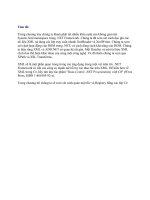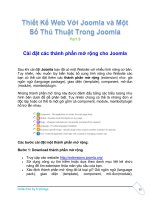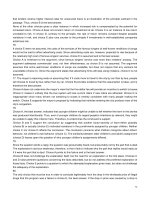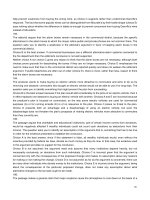Tài liệu Practical Food Microbiology 3rd Edition - Part 9 pptx
Bạn đang xem bản rút gọn của tài liệu. Xem và tải ngay bản đầy đủ của tài liệu tại đây (100.34 KB, 13 trang )
Live bivalve molluscs and
other shellfish
Council Directive 91/492/EEC [1] sets out the designation of production areas of
bivalve molluscs based on levels of Escherichia coli or faecal coliforms/100 g of
flesh and intravalvular liquid. A three-dilution, five-tube most probable number
(MPN) method is specified for testing without precise details, but other bacteri-
ological methods of equivalent accuracy are permitted. In the UK testing for
E. coli is performed because it is considered to be a more specific indicator
of faecal pollution than faecal coliforms. The microbiological criteria for the
classification of shellfish harvesting areas are shown in Table 9.1.
In addition to the classification criteria, diarrhoetic shellfish poison (DSP)
must be absent from the shellfish flesh and levels of paralytic shellfish poison
(PSP) must be below 80mg/100 g of flesh. If these levels are exceeded fishing
is prohibited in that harvesting area until compliance is achieved. Since the
publication of the Directive another shellfish poison known as amnesic shellfish
poison (ASP) has been identified; levels of ASP should be below 20mg/g of
flesh [2].
9
Live bivalve molluscs and other shellfish 229
Testing for DSP, PSP and ASP is normally performed by reference laboratories. Routine
monitoring of shellfish harvesting areas in the UK for marine biotoxins is a statutory
responsibility of the Food Standards Agency who can advise on the specialist laboratories
currently contracted to undertake this task. In England the reference facility for outbreak
related samples is the Food Safety Microbiology Laboratory, Central Public Health
Laboratory. Tel: 020 82004400, ext. 3521/4113. The UK National Reference Laboratory
for biotoxins is the Fisheries Research Services (FRS) Marine Laboratory, Aberdeen AB11
9DB. Tel: 01224 876544.
An end-product standard is defined for shellfish intended for immediate
human consumption. For faecal coliforms and E. coli this is given as category A
in Table 9.1. In addition, the shellfish should meet the standards defined above
for biotoxins and Salmonella should be absent in 25 g of shellfish flesh. The Di-
rective recognized the absence of routine virus testing procedures and this is still
true today. However consumption of molluscs containing viruses, in particular
Norwalk-like virus (NLV; also known as small round structured virus or SRSV) is
the most common cause of illness from this type of food. At present, methods for
the direct detection of viral pathogens (NLV and hepatitis A virus or HAV)
in shellfish are all based on the polymerase chain reaction (PCR). However,
processing of shellfish extracts to recover low levels of contaminating virus and
to remove PCR inhibitors is difficult. Currently these methods are complex,
poorly standardized and restricted to specialist facilities [3]. The relationship
between the levels of E. coli and the presence of virus particles in depurated shell-
fish is poor, but studies have shown a much better relationship between the
levels of certain types of phage, in particular F-specific RNA bacteriophage [4],
and the risk of viral contamination. Phage detection methods are much simpler
to perform than virus detection methods and might be incorporated more
easily into routine examination of live bivalve molluscs.
230 Section nine
Table 9.1 Classification of harvesting areas.
Category Escherichia coli/100 g Faecal coliforms/100 g Interpretation
A <230 <300 May go for direct consumption
B 90% of samples not 90% of samples not Must be depurated or relayed to
to exceed 4600 to exceed 6000 meet Category A (may also be
heat treated by approved method)
C Must not exceed Must not exceed Must be relayed for long period
46 000* 60 000 (>2 months) to meet Category A or
B (may also be heat treated by
approved method)
D >46 000* >60 000 Prohibited (may also be prohibited
on health grounds rather than
monitoring results)
*Figures not included in EEC regulations.
Testing for viral contamination (NLV and HAV) is also currently performed by reference
facilities. The Enteric Virus Unit at the Central Public Health Laboratory, Tel. 0208 200
4400, and other peripheral Public Health Laboratory Service (PHLS) laboratories can
advise on analysis of clinical samples associated with shellfish outbreaks. The UK National
Reference Laboratory for bacteriological and viral contamination of shellfish is the
Centre for Environment, Fisheries and Aquaculture Science (CEFAS), Weymouth DT4 8UB.
Tel: 01305 206600.
Method 1 Multiple tube method for Escherichia coli
This method is the standard procedure used in the UK [5]. Minerals modified gluta-
mate broth is used for the first stage of the test based on the detection of acid produc-
tion followed by detection of b-glucuronidase activity at 44°C using a chromogenic
agar for confirmation of the presence of Escherichia coli.
continued
Live bivalve molluscs and other shellfish 231
A pooled sample of at least six shellfish are required for testing to overcome the
variability associated with individual shellfish. Additional shellfish should be sub-
mitted by the sampling authority to allow for rejections. All samples should be stored
dry at 4°C and examined preferably within 6 h of collection but no later than 24 h
after collection. Samples should not be frozen.
Sample size
Oysters/clams 10–15
Mussels 15–30
Cockles 30–50.
Equipment
Stomacher (optional)
Rotary blender (optional)
Shucking knives
Balance with resolution 0.1 g or greater
Incubators at 37 ±1°C and 44±1°C.
Reagents
0.1% peptone solution (in water), pH 7.2± 0.2
0.1% peptone/0.85% sodium chloride solution
Minerals modified glutamate medium, double and single strength
5-bromo-4-chloro-3-indolyl b-
D-glucuronide (BCIG) agar. Tryptone bile agar contain-
ing 144 mmol/L 5-bromo-4-chloro-3-indolyl-b-D glucuronic acid (e.g. 0.075 g/L of
cyclohexylammonium salt).
Control cultures
NCTC 9001 Escherichia coli Positive
NCTC 13216 Escherichia coli b-glucuronidase weak positive
NCTC 9528 Klebsiella aerogenes b-glucuronidase negative
Sample preparation
(a) Select at least 10 oysters and clams, 15 mussels or 30 cockles. Discard any gaping
shellfish and those with obvious signs of damage.
(b) Clean the molluscs by scraping, scrubbing and washing under cold running water
of potable quality and allow to drain on clean paper towels.
(c) Open the molluscs with a flamed and cooled shucking knife, as follows:
Oysters/clams
Insert the knife between the two shells towards the hinge end of the shellfish, push
further into the shellfish and prise open the upper shell. Allow any liquor to drain into
a sterile weighed bag or beaker. Push the blade through the shellfish and sever the
muscle attachments by slicing across. Remove the upper shell and scrape the contents
of the lower shell into the sterile bag or beaker. Repeat for at least 10 oysters/clams to
obtain the required weight and add to the same bag or beaker.
continued
232 Section nine
Mussels/cockles
Insert the knife between the shells through the byssal opening of the shellfish and
separate the shells by twisting the knife. Collect any liquor in a weighed sterile bag or
beaker. Cut the muscle between the two shells and scrape the contents into the sterile
bag or beaker. Repeat for a minimum of 15 mussels or 30 cockles to obtain the required
weight, adding the contents to the same bag or beaker.
Preparation of homogenate
Using stomacher
(d) Place the bag containing the shellfish meat and liquor inside two more bags to
prevent puncture from shell.
(e) Place the bag in the stomacher and operate the machine for 2–3 min.
(f) Transfer 50 g of the homogenate to another stomacher bag and add approxi-
mately 100 mL from a measured 450mL volume of 0.1% peptone solution.
(g) Place the bag in the stomacher and operate the machine for 2–3 min. Add the re-
mainder of the 0.1% peptone solution and mix well. This gives the 10
-1
dilution.
or:
Using blender
(d) Weigh the shellfish flesh and liquor and add two parts by mass of 0.1% peptone
solution.
(e) Homogenize mixture in a rotary blender for sufficient time to achieve 15 000–
20 000 revolutions. The duration should not exceed 2.5min.
(f) Stand for 30s.
(g) Swirl briefly, then transfer 30 mL of the homogenate to a measured 70 mL of 0.1%
peptone solution and mix well. This gives the 10
-1
dilution.
Preparation of dilutions
(h) Prepare a 10
-2
dilution by transferring 1 mL of 10
-1
dilution to 9 mL of 0.1%
peptone/0.85% sodium chloride solution. Further dilutions may also be
required when raw molluscs are being examined for classification of shellfish
harvesting areas, i.e. 10
-3
and 10
-4
.
Procedure
(i) Prepare 15 tubes of minerals modified glutamate medium, five containing
10 mL of double strength medium and 10 containing 10mL of single strength
medium.
(j) Add 10 mL of 10
-1
dilution to each of the five tubes containing double strength
medium.
(k) Add 1mL of 10
-1
dilution to each of five tubes of single strength medium.
(l) Add 1 mL of 10
-2
dilution to each of five tubes of single strength medium.
(m) Repeat step (l) with further dilutions if necessary.
(n) Incubate all tubes at 37°C for 24±2h.
(o) Examine all tubes for acid production, signified by a colour change to yellow. The
presence of any acid, regardless of quantity, is regarded as a positive result.
Absence of acid production after 24 ±2 h constitutes a negative result for E. coli.
continued p. 237
Live bivalve molluscs and other shellfish 233
Table 9.2 Most probable number (MPN) of organisms [5]. Tables for multiple tube method
using 5 ¥ 1g, 5 ¥0.1 g, 5¥0.01g.
1 g 0.1 g 0.01 g MPN/100 g
Category A (<230 Escherichia coli)
00 0 <20
00 1 20
01 0 20
10 0 20
10 1 40
11 0 40
12 0 50
20 0 40
20 1 50
21 0 50
21 1 70
22 0 70
2 3 0 110
30 0 70
30 1 90
31 0 90
3 1 1 130
3 2 0 130
3 2 1 160
3 3 0 160
4 0 0 110
4 0 1 140
4 1 0 160
4 1 1 200
4 2 0 200
5 0 0 220
Category B (>230 E. coli, <4600 E. coli)
4 2 1 250
4 3 0 250
4 3 1 310
4 4 0 320
4 4 1 380
5 0 1 290
5 0 2 410
5 1 0 310
5 1 1 430
5 1 2 600
5 1 3 850
5 2 0 500
5 2 1 700
5 2 2 950
5 2 3 1200
5 3 0 750
Table 9.3 Most probable number (MPN) of organisms [5]. Tables for multiple tube method
using 5 ¥ 0.1g, 5 ¥0.01 g, 5¥0.001g.
0.1 g 0.01 g 0.001 g MPN/100 g
Category A (<230 Escherichia coli)
0 0 1 200
0 1 0 200
1 0 0 200
Category B (>230 E. coli, <4600 E. coli)
1 0 1 400
1 1 0 400
1 2 0 500
2 0 0 400
2 0 1 500
2 1 0 500
2 1 1 700
2 2 0 700
2 3 0 1100
3 0 0 700
3 0 1 900
3 1 0 900
3 1 1 1300
3 2 0 1300
234 Section nine
Table 9.2 continued.
1 g 0.1 g 0.01 g MPN/100 g
5 3 1 1100
5 3 2 1400
5 3 3 1750
5 3 4 2100
5 4 0 1300
5 4 1 1700
5 4 2 2200
5 4 3 2800
5 4 4 3450
5 5 0 2400
5 5 1 3500
Category C (>4600 E. coli, <46 000 E. coli)
5 5 2 5400
5 5 3 9100
S 5 4 16 000
55 5 >18 000*
*Needs further dilutions to clarify classification.
Live bivalve molluscs and other shellfish 235
Table 9.3 continued.
0.1 g 0.01 g 0.001 g MPN/100 g
3 2 1 1600
3 3 0 1600
4 0 0 1100
4 0 1 1400
4 1 0 1600
4 1 1 2000
4 2 0 2000
4 2 1 2500
4 3 0 2500
4 3 1 3100
4 4 0 3200
4 4 1 3800
5 0 0 2200
5 0 1 2900
5 0 2 4100
5 1 0 3100
5 1 1 4300
Category C (>4600 E. coli, <46 000 E. coli)
5 1 2 6000
5 1 3 8500
5 2 0 5000
5 2 1 7000
5 2 2 9500
5 2 3 12 000
5 3 0 7500
5 3 1 11 000
5 3 2 14 000
5 2 3 17 500
5 3 4 21 000
5 4 0 13 000
5 4 1 17 000
5 4 2 22 000
5 4 3 28 000
5 4 4 34 500
5 5 0 24 000
5 5 1 35 000
Prohibited (>46 000 E. coli)
5 5 2 54 000
5 5 3 91 000
5 5 4 160 000
55 5 >180 000
236 Section nine
Table 9.4 Most probably number (MPN) of organisms [5]. Tables for multiple tube method
using 5 ¥ 0.01g, 5 ¥0.001 g, 5¥0.0001g.
0.01 g 0.001 g 0.0001 g MPN/100 g
Category B (>230 Escherichia coli, <4600 E. coli)
0 0 1 2000
0 1 0 2000
1 0 0 2000
1 0 1 4000
1 1 0 4000
2 0 0 4000
Category C (>4600 E. coli, <46 000 E. coli)
1 2 0 5000
2 0 1 5000
2 1 0 5000
2 1 1 7000
2 2 0 7000
2 3 0 11 000
3 0 0 7000
3 0 1 9000
3 1 0 9000
3 1 1 13 000
3 2 0 13 000
3 2 1 16 000
3 3 0 16 000
4 0 0 11 000
4 0 1 14 000
4 1 0 16 000
4 1 1 20 000
4 2 0 20 000
4 2 1 25 000
4 3 0 25 000
4 3 1 31 000
4 4 0 32 000
4 4 1 38 000
5 0 0 22 000
5 0 1 29 000
5 0 2 41 000
5 1 0 31 000
5 1 1 43 000
Prohibited (>46 000 E. coli)
5 1 2 60 000
5 1 3 85 000
5 2 0 50 000
5 2 1 70 000
5 2 2 95 000
5 2 3 12 0000
Table 9.4 continued.
0.01 g 0.001 g 0.0001 g MPN/100 g
5 3 0 75 000
5 3 1 110 000
5 3 2 140 000
5 3 3 175 000
5 3 4 210 000
5 4 0 130 000
5 4 1 170 000
5 4 2 220 000
5 4 3 280 000
5 4 4 345 000
5 5 0 240 000
5 5 1 350 000
5 5 2 540 000
5 5 3 910 000
5 5 4 1 600000
Live bivalve molluscs and other shellfish 237
(p) Subculture each tube showing acid production to a section of BCIG agar, and
streak to obtain isolated colonies.
(q) Incubate the BCIG agar plates at 44°C for 20–24 h.
(r) Examine the plates for the presence of blue colonies, typical of b-glucuronidase
positive E. coli.
(s) Consider tubes that yield growth of blue colonies on BCIG agar as positive for the
presence of E. coli.
Calculation
(t) For each dilution, count the number of positive tubes.
(u) If dilutions of 10
-3
or higher were used, select the highest dilution having five
positive tubes and the next two higher dilutions. If no dilution contains
five positive tubes, select the three highest dilutions amongst which at least one
positive result was obtained.
(v) Use the number of positive tubes at each dilution selected to determine the
MPN by reference to the MPN table for the appropriate dilution range
(Tables 9.2–9.4). 10 mL of the 10
-1
dilution is equivalent to 1 g of flesh, 1mL of the
10
-1
dilution is equivalent to 0.1 g of flesh, etc.
Method 2 Salmonella spp.
The sample should be prepared for examination as described in steps (a)–(c) in
method 1. Homogenize the sample as described in steps (d)–(g) using either a
stomacher or a blender, but use buffered peptone water instead of 0.1% peptone
solution. Then proceed as described in Section 6.12, method 2.
238 Section nine
Method 3 Phage detection
F-specific RNA bacteriophages are bacterial viruses that have analogous morphology
and genetic structure to human pathogenic viruses (NLV, enteroviruses and HAV)
found in sewage. This, allied to their abundance in sewage and ease of enumeration,
make them a good indicator of viral contamination in the marine environment.
Their presence in shellfish is indicative of sewage pollution and potential contami-
nation by human pathogenic viruses. They are particularly useful indicators of
potential viral contamination in shellfish after treatment where traditional bacterial
indicators are removed more readily than human viruses. F-specific RNA bacterio-
phages are capable of infecting a specified F-pili producing bacterial host strain.
Infection produces visible plaques on a confluent lawn grown under appropriate
culture conditions with the infectious process being inhibited in the presence of
ribonuclease (RNase) in the plating media
Principle of method
A culture of host strain is mixed with a small volume of molten nutrient medium.
Shellfish homogenate is added and the mixture flooded on a solid nutrient agar base
and allowed to set. This is then incubated at 37°C during which time the host multi-
plies to produce a confluent lawn. Visible plaques form where bacteriophage is pres-
ent. It is assumed that each plaque is derived from one bacteriophage. Where
necessary, simultaneous examination of parallel plates with added RNase for confir-
mation by differential counts is carried out. The results are expressed as the number of
plaque forming units (pfu)/100 g of shellfish [6].
Sample size
As for method 1.
Equipment
As for method 1, and in addition:
Centrifuge
Water bath at 45 ±2°C
Spectrophotometer
Colony counter
Sterile glassware.
Reagents
1.0% calcium-glucose solution
12.5% w/v nalidixic acid solution
Tryptone yeast extract glucose broth (TYGB)
Tryptone yeast extract glucose 2% agar (TYGA2) as plates
Tryptone yeast extract glucose 1% agar (TYGA1) in 100 mL volumes
100% w/v RNase (store at –20°C)
0.1% peptone solution (negative control)
MacConkey agar
Glycerol
Chloroform.
continued
Live bivalve molluscs and other shellfish 239
Microbiological reference materials
Salmonella typhimurium strain WG49, phage type 3 Nal
r
(F¢ 42 lac:Tn5), NCTC 12484.
Bacteriophage MS2 NCO12487 (for positive control; obtainable from NCTC) (see
Appendix C).
Sample preparation
(a) Prepare the sample as described in method 1. Prepare the homogenate using
a blender, as described in steps (d) and (e) of method 1, to produce a 1/3
homogenate.
(b) Centrifuge 30–50 mL of homogenate, prepared as above, at 2000± 200 g for 5min
at room temperature.
(c) Make any decimal dilutions, if required, by adding 1 ±0.1mL of supernatant to
9 ±0.2 mL of 0.1% peptone solution.
Agar overlay preparation
(d) Melt TYGA1 then cool to 45°C in the water bath.
(e) Add 1 ±0.1 mL of 1.0% calcium-glucose solution per 100± 2 mL of TYGA1. If high
levels of background bacteria are expected add 400 ±2 mL of 12.5% w/v nalidixic
acid solution.
(f) Aliquot 2.5 ±0.1 mL of TYGA1 for each replicate sample into bijoux held at 45°C
in the water bath. (If DNA plaques are expected, for example in samples from
faecally polluted areas, perform confirmatory tests in the presence of 100 ±1 mL
100% w/v RNase).
Preparation of host
(g) Add 1± 0.1 mL of calcium-glucose solution to 100± 1 mL of TYGB at 37°C.
(h) Inoculate this medium with 1±0.1mL of S. typhimurium WG49 working culture.
(i) Incubate at 37°C for 4 ±2 h to achieve a cell density of 7–40 ¥10
7
cfu/mL at
600 nm, using sterile TYGB as the blank.
Assay
(j) Immediately after incubation add 1 ±0.1 mL of WG49 host culture to all test
bijoux followed by 1 ±0.1 mL of the sample under test. Mix contents by inverting
the bijoux.
continued
To prepare a working culture of S. typhimurium WG49, inoculate TYGB and incubate
for 18 ±2 h at 37°C. Subculture to MacConkey agar and incubate at 37°C for 18 ±2h;
then select five to seven lactose positive colonies and inoculate into 100 mL of pre-
warmed TYGB. Incubate for 5 ±1 h at 37°C, then add 20 mL glycerol. After mixing
thoroughly aliquot into plastic vials and freeze at –70°C.
Positive MS2 controls are produced by inoculating an exponentially growing culture
of S. typhimurium WG49 with MS2 NCO12487. Incubate at 37°C. After 4–5h add
5 ±1 mL of chloroform to lyse bacterial cells, then incubate at 5 ±3°C for 18 ±2h.
Centrifuge the mixture to remove cell debris. The MS2 culture is then titrated with
S. typhimurium WG49. The dilution required to give 30–500 plaques is calculated
and aliquots stored at –70°C.
240 Section nine
(k) Pour the prepared contents of each bijou over the surface of individual TYGA2
plates and distribute evenly by circular movement of the Petri dish. Repeat with
appropriate positive and negative controls.
(l) Incubate TYGA2 plates at 37°C for 18 ±4h. Count pfu within 4 h or store at 5 ±
3°C for up to 48 h.
(m) Count all plaques on each plate except those exhibiting typical DNA phage mor-
phology, i.e. plaques of approximately 6 mm diameter with a clear lysis zone in
the centre. Where dilutions have been made select plates with about 30–300 pfu.
Expression of results
Calculate the number of pfu/100 g as follows:
Where:
C
pfu
is the confirmed number of F-specific RNA bacteriophages, expressed as pfu in
1 mL of undiluted sample
N is the total number of plaques
N
RNase
is the total number of plaques counted with RNase
n is the number of replicates
F is the dilution factor.
As shellfish flesh samples are diluted 1/3 during the homogenization step, the
above result represents the number of bacteriophages in 0.3 g of shellfish. To express
results per 100 g multiply the value obtained by 300. If further dilutions were made
(step (c)) also multiply by the appropriate dilution factor.
If no plaques are present express the result as <30 pfu/100g shellfish flesh.
Interpretation
Shellfish containing levels of F-specific RNA bacteriophage of <100 pfu/100 g shellfish
flesh and intravalvular fluid are unlikely to be contaminated with viruses causing
gastroenteritis.
C
NN F
n
pfu
RNase
=
-¥
References
1 Council of the European Communities. Directive No. 91/492/EEC on shellfish
hygiene. Classification and monitoring of shellfish harvesting water. Off J Eur
Communities 1991; L268: 1–14.
2 Council of the European Communities. Directive 97/61/EC of 20 October 1997
amending the annex to Directive 91/492/EEC laying down the health conditions for
the production and placing on the market of live bivalve molluscs. Off J Eur Communi-
ties 1997; L295: 35–6.
3 Lees D. Viruses and bivalve shellfish (review). Int J Food Microbiol 2000; 59: 81–116.
4 Dore WJ, Henshilwood K, Lees DN. Evaluation of F-specific RNA bacteriophage as a
candidate human enteric virus indicator for bivalve molluscan shellfish. Appl Environ
Microbiol 2000; 66: 1280–5.
9.1
5 Donovan TJ, Gallacher S, Andrews NJ, et al. Modification of the standard method used
in the United Kingdom for counting Escherichia coli in live bivalve molluscs. Comm Dis
Public Health 1998; 1: 188–96.
6 ISO 10705-1 (BS 6068-4 Part 11 1996). Water Quality. Microbiological Methods. Detection
and Enumeration of Bacteriophages. Part 1: Enumeration of F-specific RNA Bacteriophages.
Geneva: International Organization for Standardization (ISO), 1995.
Live bivalve molluscs and other shellfish 241









